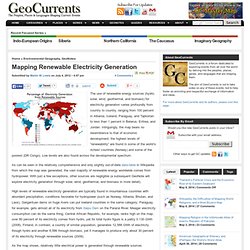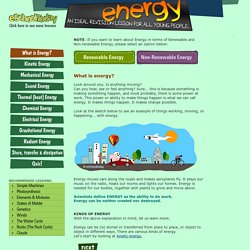

Mapping Renewable Electricity Generation. The use of renewable energy sources (hydro, solar, wind, geothermal, and biomass) for electricity generation varies profoundly from country to country, ranging from 100 percent in Albania, Iceland, Paraguay, and Tajikistan to less than 1 percent in Belarus, Eritrea, and Jordan.

Intriguingly, the map bears no resemblance to that of economic development; the highest levels of “renewability” are found in some of the world’s richest countries (Norway) and some of the poorest (DR Congo). Low levels are also found across the developmental spectrum. As can be seen in the relatively comprehensive and only slightly out-of-date data-table in Wikipedia from which the map was generated, the vast majority of renewable energy worldwide comes from hydropower. With just a few exceptions, other sources are negligible (a subsequent GeoNote will explore electricity generation through solar, wind, geothermal, and biomass in more detail). Kinds of Energy. NOTE: If you want to learn about Energy in terms of Renewable and Non-renewable Energy, please select an option below: What is energy?

Look around you. Is anything moving? Can you hear, see or feel anything? Sure... this is because something is making something happen, and most probably, there is some power at work. Look at the sketch below to see an example of things working, moving, or happening... with energy. Energy moves cars along the roads and makes aeroplanes fly. KINDS OF ENERGY With the above explanation in mind, let us learn more. Energy can be (is) stored or transferred from place to place, or object to object in different ways. Energy & Energy Transformations: Wile E Coyote & Roadrunner. Energy Kids - What Is Energy? Energy Technology. Richard Feynman Electricity. Richard Feynman Rubber Bands. Stewart Brand: 4 environmental 'heresies' David MacKay: A reality check on renewables. Mechanics of Wind-up Cell Phone Chargers " So what's going on inside a wind-up cell phone charger?

How does the simple turning of a crank lead to extra juice for your phone's battery? To understand the basics of wind-up cell phone chargers, it helps to look at a much bigger, yet surprisingly similar, technology -- wind turbines and wind power. When we use massive fans to generate electric power, we're relying on the motion of wind. In the simplest terms, the blades of the fans capture kinetic energy, or the energy of motion, from the movement of the wind.
As the blades spin, so does the shaft that the blades are attached to. A wind-up cell phone charger is like a miniature wind turbine, except instead of using wind to power a generator, your arm and hand provide the kinetic energy necessary to move the charger's crank and add battery life to your phone. Although there are various types of designs, most wind-up cell phone chargers use a similar design and basic principles to generate sufficient power.
ActewAGL education site. Energy - fuelling the future. KS3 Bitesize Science - Energy transfer and storage : Activity. Make energy useful. Energy flows. NWCCD » Teacher Lesson Plans & Resources. Energy. The_Agency_of_Design-Designing_with_Energy. Home page. Kinds of Energy. OK Go - This Too Shall Pass - Rube Goldberg Machine version - Official.